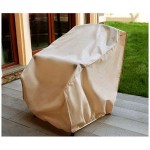How to Replace Fabric on a Patio Sling Chair
Patio sling chairs offer a comfortable and stylish seating option for outdoor spaces. However, prolonged exposure to the elements can lead to wear and tear on the fabric slings. Fading, tearing, and general deterioration necessitate replacement to restore the chair's functionality and aesthetic appeal. This article provides a comprehensive guide on how to replace the fabric on patio sling chairs, ensuring a successful and cost-effective refurbishment.
Replacing the fabric on a patio sling chair involves a series of steps that require careful attention to detail. The process typically includes removing the old fabric, measuring for the new fabric, creating the new sling, and installing it on the chair frame. Precision in measurement and careful execution of each step are crucial for achieving a professional-looking result and ensuring a snug, durable fit.
Before initiating the replacement process, gathering the necessary tools and materials is essential. The required tools may vary slightly based on the chair's construction and the chosen method, but a general list includes a flathead screwdriver, a rubber mallet, measuring tape, scissors, a sewing machine, heavy-duty thread, seam ripper, and potentially a staple gun. In terms of materials, the primary need is suitable outdoor fabric. Choose a material specifically designed for outdoor use, possessing resistance to UV rays, water, and mildew. Phifertex, Sunbrella, and Textilene are common and reliable options. It's also advisable to have spare sling rail spline available, as the existing spline may be damaged during removal.
The process might seem daunting initially, but breaking it down into manageable steps makes it achievable for most DIY enthusiasts. Patience and meticulousness are key to achieving satisfactory results and extending the lifespan of outdoor furniture.
Key Point 1: Removing the Old Sling Fabric
The first critical step is the careful removal of the existing, worn-out sling fabric. Proper removal minimizes the risk of damaging the chair frame and provides a clear template for creating the new sling. The process typically involves disassembling the chair frame to loosen the sling and then detaching the fabric from the sling rails. Here's a detailed breakdown:
1. Disassembling the Chair Frame: Most patio sling chairs are constructed with frames that can be partially disassembled. Locate the bolts or screws that hold the frame together at the top and bottom of the chair. Use a wrench or screwdriver to loosen and remove these fasteners. It is highly recommended to take photographs of the disassembly process. These photos will be invaluable when reassembling the chair later. Keep all the hardware in a safe place to prevent loss.
2. Loosening the Sling: Once the frame is partially disassembled, the tension on the sling fabric should be reduced. This allows for easier removal of the sling rail spline. The spline is a round, flexible cord that holds the fabric in place within a groove on the sling rail. With the frame loosened, the spline becomes more accessible.
3. Removing the Sling Rail Spline: Examine the sling rail to identify the starting point of the spline. Often, there’s a small gap or slightly exposed section. Use a flathead screwdriver or a specialized spline removal tool to gently pry the spline out of the groove. Work along the entire length of the rail, slowly and carefully pulling the spline free. Avoid excessive force, as this can damage the spline or the sling rail itself. If the spline breaks during removal, this is a good indication that replacement is necessary. Repeat this process on all sides of the sling where the fabric is secured by spline.
4. Removing the Old Fabric: With the spline removed, the old fabric should be easily detachable from the sling rails. If staples or other fasteners were additionally used, employ a staple remover or pliers to remove them. Once all fasteners are removed, carefully detach the old fabric from the frame. Be mindful of any sharp edges or potential snags that could cause injury or damage to the chair frame.
5. Preserving Components: Save the old sling rail spline if it is in good condition. It can be reused, provided it's not brittle or damaged. The old fabric can be used as a template to cut the new fabric. However, keep in mind that the old fabric might have stretched or shrunk, so precise measurements are still crucial.
Key Point 2: Measuring and Cutting the New Sling Fabric
Accurate measurement and precise cutting are paramount for achieving a well-fitted sling. Incorrect measurements will lead to a sling that is either too tight or too loose, compromising comfort and durability. The following steps outline the process for ensuring accurate measurements and precise cuts:
1. Measuring the Sling Rails: The length of the fabric is determined by the distance between the sling rails on the chair frame. Use a measuring tape to measure the distance between the two rails. Ensure the tape measure is straight and taut to obtain an accurate measurement. This measurement represents the length of the fabric piece to be cut. Record this measurement accurately.
2. Measuring the Width of the Fabric: The width of the fabric needs to account for the distance between the sling rails and the overlap required to insert the spline. Measure the width of the existing fabric, if available. If the old fabric is unusable, measure the distance from the groove on one side of the sling rail to the groove on the opposite side. Add an extra inch or two to each side to allow for the spline insertion and a secure fit. This additional allowance is crucial for creating a smooth, taut sling. Record this measurement accurately.
3. Cutting the Fabric: Lay the chosen outdoor fabric on a flat, stable surface. Using a fabric marker or chalk, mark the measured dimensions on the fabric. Double-check the measurements before cutting to prevent errors. Use sharp fabric scissors or a rotary cutter to cut the fabric along the marked lines. Ensure the cut is clean and straight to prevent fraying and ensure a professional finish. If using the old fabric as a template, lay it on top of the new fabric, secure it with pins, and cut along the edges of the old fabric, adding the necessary allowances for spline insertion.
4. Hemming the Edges (Optional): Hemming the edges of the fabric adds to the sling's durability and prevents fraying. Fold over approximately half an inch of fabric on each edge and press with an iron. Fold over another half an inch and press again. Secure the hem with pins and sew along the edge using a sewing machine and heavy-duty thread. This step is particularly important for fabrics prone to fraying. If the fabric is a tightly woven mesh like Phifertex, hemming might not be necessary.
Key Point 3: Installing the New Sling Fabric
Installing the new sling fabric requires careful insertion of the spline into the sling rails. This process demands patience and attention to detail to ensure a secure and aesthetically pleasing outcome. The following steps outline the installation process:
1. Positioning the Fabric: Align the new fabric sling with the chair frame. Ensure the fabric is centered and the edges are even. This ensures a uniform appearance and proper tension distribution. Temporarily securing the fabric with clamps or pins can be helpful during the initial positioning.
2. Inserting the Spline: Begin inserting the sling rail spline into the groove on one side of the sling rail. Start at one end and gradually work your way along the entire length of the rail. Use your fingers or a rubber mallet to gently push the spline into the groove. Avoid using excessive force, as this can damage the spline or the sling rail. Ensure that the fabric is pulled taut as you insert the spline to achieve a smooth, wrinkle-free finish. A specialized spline roller tool can be helpful to evenly insert the spline into the groove.
3. Securing the Opposite Side: Once one side is secured, repeat the process on the opposite side of the chair. Ensure the fabric is pulled taut before inserting the spline. This step is crucial for achieving the desired tension and preventing sagging. Take your time and make sure the fabric is evenly distributed between the two rails.
4. Trimming Excess Fabric: After the spline is fully inserted on both sides, trim any excess fabric that extends beyond the sling rails. Use sharp scissors to trim the fabric close to the spline. Be careful not to cut the spline itself. A clean, precise trim contributes to a professional appearance.
5. Reassembling the Chair Frame: Reassemble the chair frame by reversing the disassembly steps. Align the frame components and reinsert the bolts or screws. Tighten the fasteners securely to ensure the chair is stable and safe to use. Refer to the photographs taken during disassembly to ensure correct reassembly.
6. Final Inspection: After reassembling the chair, conduct a thorough inspection. Check the fabric tension, the spline insertion, and the overall stability of the chair. Make any necessary adjustments to ensure a satisfactory result. Sit in the chair to test the comfort and support provided by the new sling fabric. Address any issues or concerns promptly.
Replacing the fabric on patio sling chairs, while requiring patience and attention to detail, is a rewarding project that can significantly extend the lifespan of outdoor furniture. By following these steps carefully, individuals can achieve professional-looking results and enjoy their refurbished patio chairs for years to come.

How To Replace Two Piece Sling Chair Fabric

Replacement Sling Cover For Patio Furniture Make Your Own

How To Replace Fabric On A Patio Sling Chair

How To Replace Outdoor Sling Chair Fabric With Phifertex

How To Replace Fabric On A Sling Chair Ofs Maker S Mill

How To Replace Fabric On A Patio Sling Chair

Diy Replacement Slings For Patio Chairs Absolute Furniture

Tropitone Sling Chair Replacement S Furniture

Diy Replacement Slings For Patio Chairs Absolute Furniture

Replacing Fabric In Sling Back Director S Chairs








